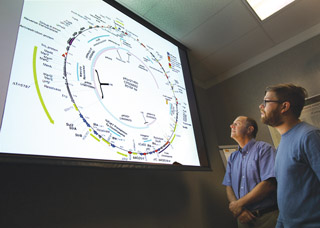
Kelly Williams, right, and Corey Hudson (both 8623) look at the mosaic pattern of one of the Klebsiella pneumoniae plasmids and discuss mechanisms that mobilize resistance genes. (Photo by Dino Vournas)
Imagine going to the hospital with one disease and coming home with something much worse, or not coming home at all.
With the spread of antibiotic resistance, healthcare-associated infections have become a serious threat. In fact, on any given day about one in 25 hospital patients has at least one such infection and as many as one in nine of those die as a result, according to the Centers for Disease Control.
Consider Klebsiella pneumoniae, not typically a ferocious pathogen, but now armed with resistance to virtually all antibiotics in clinical use; it is the most common species of carbapenem-resistant Enterobacteriaceae (CRE) in the United States. Carbapenems are considered the antibiotic of last resort.
But there is hope — a team of Sandia microbiologists recently sequenced the entire genome of a Klebsiella pneumoniae strain encoding New Delhi Metallo-beta-lactamase (NDM-1), an enzyme that breaks down carbapenems and renders them ineffective.
CREs are a wholly different group of antibiotic-resistant bacteria than the better-known methicillin-resistant Staphylococcus aureus (MRSA). CREs are considered a “triple threat” because of their resistance to nearly all antibiotics, high mortality rates, and ability to spread their resistance to other bacteria.
Having sequenced the entire genome of the NDM-1 strain Klebsiella pneumoniae for the first time, the Sandia team of Corey Hudson (8623), Zach Bent (8623), Robert Meagher (8621) and Kelly Williams (8623) are beginning to understand the bacteria’s multifaceted mechanisms for resistance. They presented their findings in a paper recently published in PLOS One, “Resistance Determinants and Mobile Genetic Elements of an NDM-1 Encoding Klebsiella pneumoniae Strain.”
An eye-opener
“Once we had the entire genome sequenced, it was a real eye-opener to see the concentration of so many antibiotic-resistant genes and so many different mechanisms for accumulating them,” says Kelly, a bioinformaticist. “Just sequencing this genome unlocked a vault of information about how genes move between bacteria and how DNA moves within the chromosome.”
Robert first worked with Klebsiella pneumoniae ATCC BAA-2146 (Kpn2146), the first US isolate found to encode NDM-1, last year. Along with E.coli, it was used to test an automatic DNA sequencing preparation platform for the RapTOR Grand Challenge, a project that developed techniques to allow discovery of pathogens in clinical samples.
“I’ve been interested in multi-drug resistant organisms for some time. The NDM-1 drug resistance trait is spreading rapidly worldwide, so there is a great need for diagnostic tools,” says Robert. “This particular strain of Klebsiella pneumoniae is fascinating and terrifying because it’s resistant to practically everything. Some of that you can explain on the basis on NDM-1, but it’s also resistant to other classes of antibiotics that NDM-1 has no bearing on.”
Unlocking Klebsiella pneumoniae
Assembling an entire genome is like putting together a puzzle. The researchers needed two genomic datasets, Illumina and Pacific Biosciences (PacBio), to assemble Klebsiella pneumoniae. The Illumina pair-end genomic sequence dataset, done at Sandia, provided accurate but short reads. The PacBio dataset contained much longer reads with less accuracy.
Klebsiella pneumoniae turned out to have one large chromosome and four plasmids, smaller DNA circles physically separate from and able to replicate independently of a cell’s chromosomal DNA. Plasmids often carry antibiotic-resistant genes and other defense mechanisms.
The researchers discovered that their Klebsiella pneumoniae bacteria encoded 34 separate enzymes of antibiotic resistance, as well as efflux pumps that move compounds out of cells and mutations in chromosomal genes that are expected to confer resistance.
“Each one of those genes has a story. How it got into this bacteria, where it has been, and how it has evolved,” says Kelly.
The researchers also identified several mechanisms that mobilize resistance genes: acquisition of plasmids and genomic islands; integron cassette swapping; transposition events from chromosome to plasmid and vice versa; and homologous recombination at high copy repeats.
Necessity leads to development of new tools
In the course of mapping out the many tricks and weapons of Klebsiella pneumoniae, the research team developed several new bioinformatics tools for identifying established mechanisms of genetic movement.
Kelly and Corey detected circular forms of transposons, or “jumping genes,” in movement, which has never before been shown this way, and discovered sites within the genome undergoing homologous recombination. By applying two existing bioinformatics methods for detecting genomic islands, they found a third class of islands that neither method alone could have detected.
“To some extent, every extra piece of DNA that a bacteria acquires comes at some cost, so the bacteria doesn’t usually hang onto traits it doesn’t need,” says Corey. “The further we dug down into the genome, the more stories we found about movement within the organism and from other organisms and the history of insults, like antibiotics, that it has faced. This particular bacteria is just getting nastier over time.”
Translating findings to diagnostics
The researchers are now applying their understanding of Klebsiella pneumoniae’s mechanisms of resistance and their new bioinformatics tools to develop diagnostic tools to detect bioengineering. Looking across 10 related but distinct strains of Klebsiella pneumoniae, they pinpointed regions that were new to their strain, and so indicate genetic movement.
“By studying the pattern of movement, we can better characterize a natural genomic island,” says Corey. “We are now using that knowledge to characterize unnatural islands, which would be an indication of bioengineering.”
The findings are also being applied to another Laboratory Directed Research and Development project led by Eric Carnes (8635) that is examining alternative approaches for treating drug resistant organisms. “Instead of traditional antibiotics, we use a sequence-based approach to silence expression of drug resistant genes,” explains Meagher.
The importance of this research can be summed up nicely by an oft-quoted line from Sun Tzu’s Art of War — know the enemy.